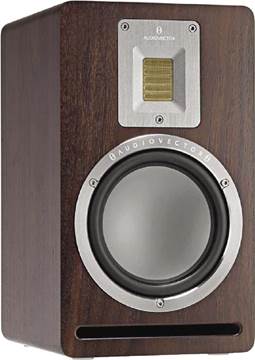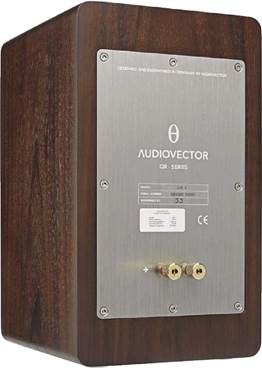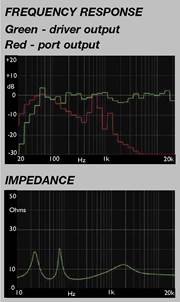AUDIOVECTOR QR1 Review: Racy Ribbon
Audiovector’s affordable QR1 ribbon loudspeakers enter the ribbon race for fast highs, says Noel Keywood. Read our AUDIOVECTOR QR1 Review.
I always like to review a loudspeaker with a ribbon tweeter, since they give fast, clean treble. And Audiovector’s QR1, parades its ribbon proudly. With a gold plated grille and machined aluminium surround this drive unit is meant for display: it looks intriguingly hi-tech as our pictures show. So potentially here is a compact loudspeaker different to the norm, looking good at the price. Accompanying the tweeter in this compact design from Denmark is a “6in” (152mm) bass/midrange that sits below.
Because ribbon tweeters use a lightweight alloy foil they’re commonly matched to an alloy midrange unit and that’s what Audiovector have chosen to do in the QRI. They say this unit has a three-layer “sandwich” construction comprising alloy layers with damping membrane between them, for pistonic motion. The difficulty here has always been to get a midrange unit able to reach high enough to match a ribbon, as I’m aware from wrestling with a Tonigen ribbon back in the 1990s where bridging the gap was difficult for our first KLS1 loudspeaker, inspired to some degree by the Heybrook Sextet (designer Peter Comeau) that brought my attention to the Tonigen.

Back then, ribbons did not go low, ignoring a Celestion ribbon designed by Graham Bank that I have no experience of. But ribbons have always had a good reputation for sound quality and I see Audiovector label this one an AMT in their specs, short for Air Motion Transformer (invented by Oscar Heil). It’s a slightly different way to use a ribbon, concertina form adding mass to give better downward frequency extension – and that’s what the QRI exploits. Audiovector state crossover frequency as 3kHz, meaning their AMT reaches down as low as a dome tweeter – and our measurements confirm this. Making its subjective contribution obvious.

An attractive front panel with alloy drive unit surrounds, an AMT ribbon tweeter at top and “6in” bass/midrange unit below. The latter uses a metal sandwich cone for light weight and stiffness, plus good damping to minimise colouration. At bottom lies a slot port.
The bass/midrange unit is loaded by a cabinet measuring 325mm high, 190mm wide and 232mm deep, with a slot port on its front face – not the rear. Front ports can deliver box colouration direct to a listener, which is why they are usually sited at rear. And indeed this port did deliver unwanted output measurement showed but its effect was slight. Not a big issue in the scheme of things methinks.
Audiovector use a real wood veneer they say, for White Silk, Black Piano and Dark
“this recording suited the QR1s, making them sound easy going yet insightful; guitar strings were deliciously sweet”
Walnut finish options and our review samples were Dark Walnut. It’s important to mention that they come with magnetically attached grilles that, although using a light material, do affect high frequency output from the tweeter to a useful degree. I found the grilles consequential in listening.
At rear there are single terminals that negate bi-wiring, probably not an issue for most users. With no rear port the loudspeakers can be used against a rear wall and they have been designed for such placement, to best use the acoustic characteristics of a room to strengthen low bass.
SOUND QUALITY
The QRIs were driven by a Creek iA20 amplifier, connected through Chord Company Signature Reference cables. Our Oppo UDP- 205D universal player was used as a CD transport and hi-res DAC, connected to the Creek through a QED Quartz glass fibre optical cable, for electrical isolation. A MacBook Pro delivered in hi-res from an Audirvana Plus software player, providing PCM and DSD digital.
With its attractive front fascia I started out with grilles off, but as measurement suggested the QRIs were not only bright up top but had treble spit, Willy DeVille’s sibilants into the microphone, singing Spanish Harlem (CD), having a piercing quality. We ran in the QRIs for 72 hours but I and others in the office found them harsh when used like this all the same.
Attaching the grilles usefully reduced treble presence, allowing me to move my attention to what the loudspeaker was doing

A machined and well finished alloy surround frames the Air Motion Transformer (AMT) ribbon tweeter that sits behind a gold finish protective mesh grille. This tweeter covers a relatively wide frequency range, reaching down to 3kHz Audiovector say.

A clean rear face, without the usual port. This seemingly eases placement against a rear wall. However, terminals with 4mm plugs still impose a gap sufficient to avoid port chuffing. elsewhere.
And as Audiovector say “music sounds warm”: there was a pleasantly soft balance caused by the midrange dip. This made vocals less forward than with many of today’s loudspeakers, Skin sounding almost gentle shouting out from Skunk Anansie’s Hedonism. I like this sort of presentation, better gentle than fierce, but the QRIs were obviously a tad soft at times, ignoring the tweeter that did its own thing up top.
Generally, the ‘speakers have an even but not fulsome balance, coming over as clean and concise. With Josefine Cronholm’s In Your Wild Garden the bass line was light in timbre, with little low end power. But there was air and space around her vocals. Our listening room is large (6550 cu ft) and the QRIs were a bit lost here: they need a small-ish room where what’s known as ‘room gain’ will raise bass presence, giving a balanced sound, whilst minimising room boom.
There was good insight into the strings of Antonio Forcione’s guitar with Tears of Joy, helped by swathes of high detail. I got to hear right into what his fingers were doing and percussion came over as clean and airy. Audiovector’s ribbon unit showed its worth here, giving a sense of concise treble beyond that of domes.
Spinning Loreena
McKennitt’s Gates of Istanbul (CD) her vocals were mildly clear and easy on my ear, but the rumbling bass intro was on the dry side and not overly expressive; I wanted to hear a bit more from low down as even small loudspeakers can manage.
Turning to LP, with an Audio Technica VM750 SH moving magnet (MM) cartridge connected directly into the Creek, the QRIs changed for the better. Spinning Mark Knopfler’s True Love Will Never Die, from Kill to Get Crimson, the intrinsic warmth and body of this recording suited the QRIs, making them sound easy going yet insightful, guitar strings were deliciously sweet. Where CD delivers quantisation distortion a ribbon tweeter brutally highlights, LP gives easier analogue and here Audiovector’s ribbon came on-song, making plucked strings enjoyable. There was still a mild delivery of vocals though. Running through a wide selection of LPs with volume up I became aware of some slight box boof, likely coming from the front port.
CONCLUSION
Audiovector’s QRIs offered a gently clean and easy sound, albeit with a ribbon tweeter that is forward with grilles off, but civil with grilles on. Then they shone. With excellent build quality and a high standard of finish, at the price they have a lot to offer and are certainly worth auditioning.
MEASURED PERFORMANCE
With grille on and measured 20 degrees off-axis our analysis shows the bass/midrange unit of Audiovector’s QR1 covers a wide range, from 50Hz to 2.5kHz, but high frequency output rolls down above 1kHz to produce a midrange dip that will soften the sound. Rivals give stronger output here for more intense detail and the sudden change in output level between bass/midrange and tweeter will reduce subjective coherence between the two.
The ribbon tweeter has +2dB lift with grille off – enough to make it subjectively obvious, giving the loudspeaker a bright sound balance. The grille usefully reduces output by -1dB and off-axis listening reduces the 16kHz peak to give the acceptably flat response shown.
The bass/midrange unit provides reasonably smooth output down to 50Hz, aided by the front-firing slot port (red trace) that has a resonant frequency of 55Hz. There is a strong peak at 600Hz from the port, suggesting colouration. With no lift in output across the lower midband the QR1 will lack warmth; it is best used against a rear wall to exploit room gain for bass support.
Sensitivity was good for a small cabinet, measuring 87dB sound pressure level (loud-ish) from one nominal Watt (2.8V) of input at 1 metre distance, making a 60 Watt+ amplifier best suited. Impedance measured 6 Ohms using pink noise, d.c.r. being 3.6 Ohms (nominally 4 Ohm bass unit). Our impedance trace shows a classic two-way with port dip at 55Hz and crossover peak at 2.5kHz where the tweeter starts to draw current, impedance decreasing.
The Audiovector measured well except there’s a classic crossover dip and to avoid sharp sound the grille must be on.

Verdict
The drivers: Audiovector QR 1 loudspeaker Deep unboxing
Audiovector QR-1 Review: Unleashing the True Sound Experience
The Audiovector QR-1 speakers are reviewed in this YouTube video. The speakers are compact and stylish with a sleek design.






